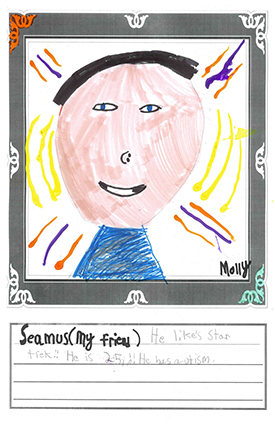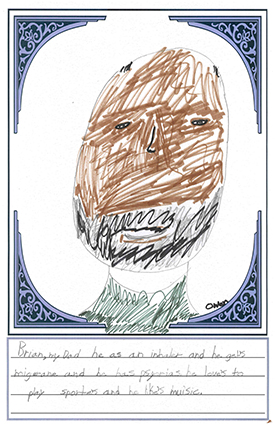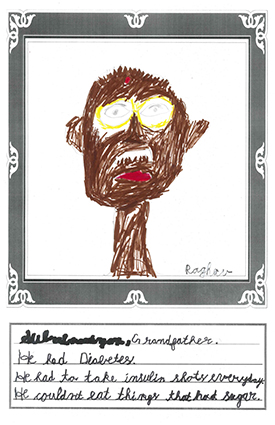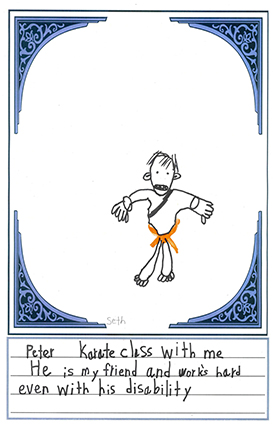
Getting Ready for a Storm
Overview
This lesson gives students the opportunity to learn how to plan ahead for weather and other emergencies and engages students as active participants in proactive emergency preparedness activities, designed to help people with and without disabilities if and when an emergency does happen. During this lesson teachers and administrators can explain the services that the school and other local emergency centers have put in place to help the community in weather or other emergencies.
The stories and activities in this lesson help students and teachers learn about and discuss what we can do to help each other prepare for local emergencies and the possible loss of electricity, water and other services. One goal of this lesson is to help students realize that things are safer and better for everyone when we plan ahead.
A planning tool, Emergency Preparedness for All, is provided with this lesson. It was developed by Vermonters to help individuals and families with and without disabilities prepare for weather and other emergencies. It is also available online at Green Mountain Guide for Emergency Planning.
Disability Awareness Focus: Emergency Preparedness for All.
Grade Level: K–6 but can be adapted for all grades.
Subject(s): Reading and Language Arts, Science and Health.

Learning Objectives
- Become familiar with basic emergency preparedness activities for individuals, families, schools and communities.
- Communicate and document emergency preparedness interests and needs.
- Better understand the impact of weather on individuals, families and communities.

Standards
Follow agreed-upon rules for discussions (e.g., listening to others with care, speaking one at a time about the topics and texts under discussion).
Plan and carry out investigations.
Build a strong base of knowledge through content-rich texts.
Ask questions to clear up any confusion about the topics under discussion.
Obtain, evaluate and communicate information.

Materials
- Chalkboard, whiteboard or flip chart, plus markers.
- Paper, crayons and colored pens for optional art project.
- Information on school and/or community’s emergency plan.
- Green Mountain Guide for Emergency Planning.
- Reading and discussion books (see suggestions, below).

Directions
Time: One 40-minute session, with supplemental activities for follow-up if desired.
Setting: Large group discussion and small group activity with worksheets for older students.
Preparation
Because each student, classroom, school and community may have unique histories with and concerns regarding emergency preparedness, teachers can and should adapt this lesson to address particular experiences and concerns. This lesson offers ideas and suggestions that can be adapted to your school and community and to the needs and concerns of your students.
Talking about safety can be difficult, particularly for students, staff and teachers who have experienced past trauma during a weather emergency or other disasters. If this is a concern, you may want to plan this lesson with school administrators or counselors, families, or other teachers or staff who work with students in your class. The intent of this lesson is to have a safe and supportive discussion, let students know about available community and school resources and safety strategies, and help students see how planning can make things easier if and when emergencies happen.
Lesson Implementation
Activity 1: Reading for Understanding
Read a book about a storm, such as “The Storm,” by Marc Harshman (Trumpet, 1995) or “Sosu’s Call,” by Meshack Asare (Kane /Miller, 2002). These books deal with both disability and weather and help students with and without disabilities to see the common concerns about self-esteem and safety that children with and without disabilities share. Other possible readings are provided in the resource listings for this lesson, along with discussion questions for each book or other material.
Activity 2: At Home or on the Move
Sometimes people stay at home during really bad weather and sometimes they are asked to move to a safer place. Ask students to think about the story they just read and their own experiences with bad weather: What are some of the things people need?
Ask the class to get ready to brainstorm things that students and others in their household might need or want to have available in an emergency.
Tell students we are going to make two emergency lists on a board or flip chart. On the left side we will list things we might need and want to have at home, and on the right side we will list what we might need and want to have with us at a local shelter. A list of possible items for your discussion is provided below, but your class may think of additional things that should be included in a disaster plan for their home, school or community shelter. It is important to give students a chance to identify different kinds of “comfort items,” including photographs and small family items, or games that do not require electricity. It might not be possible for individuals and families to have all of their favorite things with or around them, but planning ahead can help them identify and include some personal favorites in a personal or family emergency bag.
Some Ideas for the Stay Home and Go Lists
Important personal and family information/identification papers, water, food (including things that do not require refrigeration or cooking), warm clothes and gloves for cold and wet weather, pet and service animal supplies, extra medicine for a week, games, books and other activities, soap and hand cleaner, flashlight or battery-run lanterns, candles, matches, lighter, adaptive equipment and medical aids, first aid kit.
Supplemental Activity
Favorite People, Places and Things: Everyone has things that help them feel good. It could be a favorite place, either real or imagined, a person or group they love to be with, an activity they love to do, or an object that they like to have near. During sharing circle or another class activity, ask students to write or draw their chosen favorite people, place or activity and share it with the class if they feel comfortable doing so. Later, they can add this writing or artwork to their own Getting Ready for Emergencies folder, where it can help them remember to include time to include favorite places, activities and people in their emergency planning. For example, some people may want to add photos, art materials, games or contact information for friends and family members in their own emergency-planning folder. Others may want to ask what activities and services the school or community spaces will have available for people who need to stay there during an emergency.
Before and After a Storm Art Activity: Imagine the weather. Students can make collages, paintings, or drawings or poems of different kinds of stormy weather and then draw or write their own “After the Storm” image or poem. Students with dance and performance skills could create a dance or mime that reflects the changing experience of weather.
Resource for More In-Depth Planning: “The Green Mountain Guide for Emergency Planning,” included with the lesson, has places to write down important personal and family information and local emergency contacts as well as Go and Stay Checklists and pages that help families and other partners anticipate and document the specific needs of family or household members, including children and adults with different disabilities. Families and schools can use the guide to document particular communication and support needs as well as medical and disability-specific services that need to be available so that emergency personnel and community volunteers are better able to provide help in an emergency.
Resources
General Resources
Books About Children With and Without Disabilities Dealing with Storms and Other Emergencies: “The Storm,” by Marc Harshman (Trumpet, 1995) is set in a rural community and follows Jonathan, a boy who uses a wheelchair, as he participates in a school discussion about preparing for emergencies in a tornado area, and then finds himself alone on his family’s farm as a tornado hits. The book does a good job of addressing disability and the questions that children with and without disabilities have about themselves, their fears and their strengths. Discussion questions: What happens in this story? How does Jonathan feel about storms? What are some of the things the school and the radio station did to help people prepare for an emergency? What were some of the clues that bad weather was coming? What happens during the tornado and what does Jonathan do? How does Jonathan want to be treated before and after the storm?
In “Sosu’s Call,” by Meshack Asare (Kane/Miller, 2002), Sosu wants to be a part of the life of his small village near the sea. Instead his father is told that a boy who cannot walk should be kept apart because he might bring bad luck. So Sosu never leaves home and envies his dog running after his sisters and brothers as they head off to school. One day a storm comes up suddenly while everyone is away except the very old and the very young and Sosu. What can he do? Discussion questions: What is this story about? How do the people in Sosu’s village respond to his disability? What helps him when he is feeling alone? What are the warning signs that a flood is coming? How does Sosu handle the storm?
“A Storm Called Katrina,” by Myron Uhlberg (Peachtree, 2011), uses simple words and glorious pictures to tell the story of 10-year-old Louis Daniel and his family after Hurricane Katrina. When the storm separates Louis’ father from the rest of the family, Louis uses music to bring them back together again. Discussion questions: What happens during this story? How do Louis and his family know that a bad storm is coming and what do people do to prepare? What does Louis choose to take with him? What are some of the hard things that happen when the storm arrives? Were there any good surprises? How did Louis and his family help each other? Did reading this story give you some ideas of how to prepare for a bad storm?
“Snowflakes Fall,” by Patricia MacLachlan and Steven Kellogg (Random House, 2013) was written for and inspired by the community of Sandy Hook, where so many children died during school killings. You may or may not want to tell this background; but consider reading the story itself for the way the author and illustrator use images of a winter storm to recognize and celebrate the unique beauty of every child, each as different as snowflakes and as wonderful.
The Include! booklist on this website also includes other books that show children dealing with disability and natural and human disasters. These include: “The Cay,” by Theodore Taylor; “The Storyteller’s Beads,” by Jane Kurtz; and “Kami and the Yaks,” by Andrea Stenn Stryer.